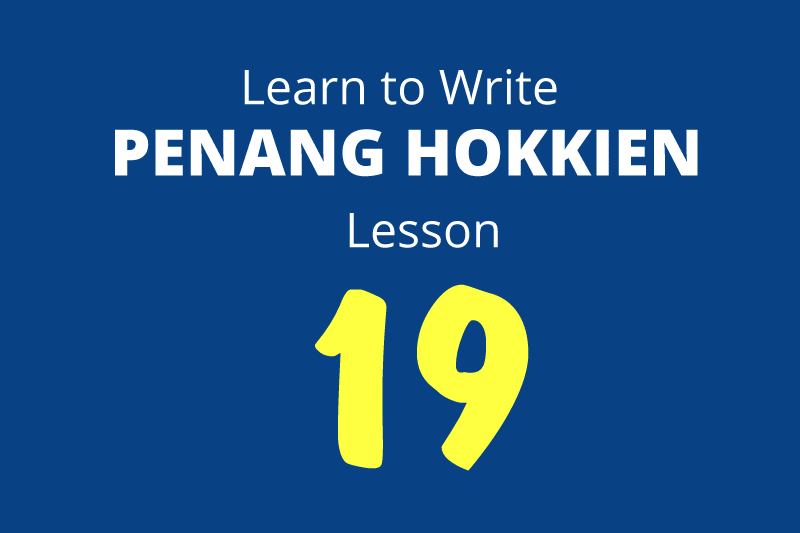
In this lesson, we get our first glimpse of verbs in Penang Hokkien. The good news about verbs in Penang Hokkien is that they do not undergo conjugation (no go, goes, gone, went, etc.). However, verbs do often take on either the citation tone or the sandhi tone, depending on their usage.
As a recap, the citation tone is the tone of the word when you take it from the dictionary. The sandhi tone is the changes (ref to Lesson 5, Penang Hokkien Tone Sandhi)
Intransitive verbs (verbs that do not allow an object) are always in the citation tone.
Wah1 cau4.

I run.
Ie1 puat3to4 lok3 long3kau1.
 He fell into the drain.
He fell into the drain.Ee1 kha3sau3 boh3theng3-boh3theng2.
 She coughed non stop.
She coughed non stop.Among transitive verbs (verbs that allow an object), it depends on whether the object is a noun or pronoun, human or non-human. Some verbs also carry different meaning when used with humans or with non-humans. Generally, the verb is in the sandhi tone when used with non humans, and in the citation tone when used with humans.
Let's look at some examples of verbs in use. The verb "ciak1" means "to eat" when the object is a non human, but "to swindle" when the object is human. In other words, when used with edible things, ciak1 takes on the literal meaning, but when used with people, it takes on the figurative meaning.
Ie1 ciak3 hu2.
 He ate fish.
He ate fish.Heh1-leh1 kao4 ciak3 bak3.

The dog eats meat.
Ie1 ciak1 wah4.

He swindles me.
Heh1-leh1 beh33 bak3-eh3 lang2 ciak1 heh1-leh1 lau33 ca3bor4.
 The butcher swindles the old woman.
The butcher swindles the old woman.Beh33 chye3-eh3 lang2 ciak1 Ah3 Choo1.

The vegetable seller swindles Ah Choo.
If a verb can be used on both object and people with the literal meaning, it sandhis in front of the object. However, if there is a possessive adjective between the verb and the object, then the verb is in citation form.
Ie1 that1 bort1.

He kicks the ball.
Ie1 that1 lang2

He kicks people.
but ... Ie1 that3 ie1-eh3 lang3.

He kicks his people.
Another example: Ie1 phak1 kao4.

He beats the dog.
Ie1 phak1 knia4.

He beats (his) child.
Ie1 phak3 ie1-eh3 knia4.

He beats his child.
Notice that the presence of the possessive adjective changes the verb from sandhi to citation form.
The verb "tua3" means "to stay", "to live" or "to be located at". In the following examples, note that when a verb is used with a non-human object, it sandhis, but if it is used with an adverb, it does not.
Ie1 tua1 pang3keng1.

He is in the bedroom.
Ie1 tua1 Sin3ka3por1.

He lives in Singapore.
Ie1 tua1 i3seng3kuan4.

He is in the hospital.
Ie1 tua1 chu3.

He is at home.
Ie1 tua3 wah1-eh3 chu3.

He stays at my house.
Ie1 tua3 cit1-peng2.

He lives here.
Ie1 tua3 heh1-peng2.

He lives there.
Some verbs may be both transitive and intransitive.
For example: Ie1 khoon3.

He sleeps.
Ie1 khoon3 liau4 nia2?

Has he fallen asleep?
Ie1 khoon1 cherng2.

He is bedridden.
Ie1 khoon3 ti1 bin3cherng2

He is lying on the bed.
In the above example, the verb khoon3 is in the citation form in sentences 1, 2 and 4. In sentence 2, the presence of particles (liau4 nia2) does not affect the verb. However, in sentence 3, the presence of an object (cherng2) changes the verb from citation to sandhi form. In sentence 4, the presence of a prepositional phrase (ti1 bin3cherng2) also does not affect the verb.
Most verbs behave in the same way as those shown in the examples above. When there's an object behind the verb, the verb is usually in the sandhi form, except if (a) there's a possessive adjective, (b) where the verb is used in the figurative form. Where there's no object behind the verb, the verb is usually in the citation form. Particles, prepositions and adverbs added behind a verb do not change the verb from the citation to the sandhi form. In our next lesson, we learn two very common verbs, si33 and uh33.
Previous Lesson | Main Page | Next Lesson
Language Learning Tools
Use the following language learning tools to learn Penang Hokkien!Learn Penang Hokkien with uTalk
This app opens the door to over 150 languages.Return to Penang Hokkien Resources

Copyright © 2003-2025 Timothy Tye. All Rights Reserved.

 Go Back
Go Back
